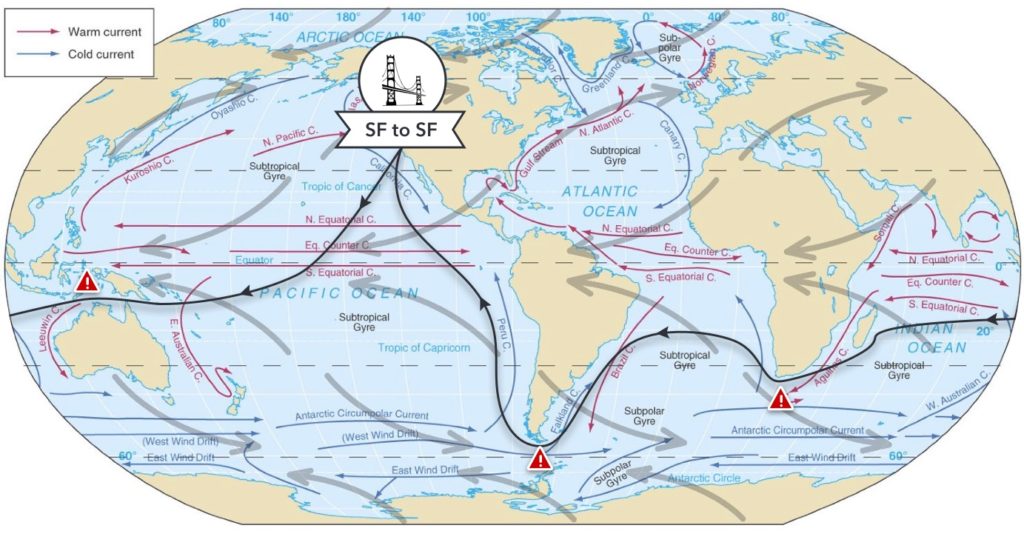There are many ways to sail around Earth. Some people do it in 5 years with their family, with stops in between, and enjoy visiting many countries along the way. And that would be a beautiful way to do it. That’s not what this adventure is about. Not now, not yet. The course is designed to be sailed solo, continuously (i.e. non-stop), the starting line doubling as the finish line, under sail alone (no engine), without assistance. That’s the goal (here’s the why).
Most long-distance sailing courses are designed to follow the prevailing seas and winds. It is much easier, much more comfortable, less dangerous, faster. Historically most non-stop circumnavigations started in the Atlantic (Europe or the East Coast of America). From there, sailing with the wind means sailing East, going under South Africa into the Southern Ocean, South of Australia, around Cape Horn, and then back home in the Atlantic.
Going the wrong way!
We live on the West Coast of North America; going East from here doesn’t make as much sense, as returning home after passing Australia means going upwind for a long long time, a very uncomfortable, likely slow, proposition. We should look at going West instead. The course would leave from San Francisco, going West through the Pacific Ocean, crossing the Equator, through Torres Strait into the Indian Ocean, dipping below South Africa and across the Atlantic, dropping all the way down South America into the Southern Ocean, to finally make a return home through the Pacific, another Equator crossing, and finally San Francisco again.
What are the difficult passages?
There are several difficult passages along this course:
- Torres Strait is a very narrow and difficult passage under sail (no engine here); the area is ripe with very light and variable wind, strong tidal currents, lots of large ship traffic, and of course reef and shoal galore.
- Crossing the Agulhas current at the tip of South Africa can be the source of very dangerous waves when the wind blows against the current direction.
- Passing Cape Horn is hard enough going East; going West around Cape Horn is a very risky proposition.
- In order to pass Cape Horn in the best possible
conditions it will not be possible to avoid hurricane seasons in all other areas.
After discussing with a few meteorologists this seems doable. The start would be around mid-September to increase the chances of a safe passage around Cape Horn. However, as you may know, the climate has been changing; extreme weather is becoming more commonplace. Whatever course we designed to avoid the worst, it is really just a plan, nothing more, nothing less. What happens after the start is what will happen:
What are the risks?
So what could possibly go wrong? Here are a few possibilities; all these do happen, not often, but they are risks to be reckonned with:
- Collision: with another boat, with a submerged object, with icebergs, with a whale. A collision with any of these could cause a hull breach, a loss of the keel or rudders.
- Grounding, collision with land: rocks,
submerged or not, reefs, are not nice to boats and can grind through fiberglass, breaching the hull. - Severe weather causing a loss of the mast.
- Personal injury or sickness: at sea, there is no doctor, no surgery room, no pharmacy. Small events can deteriorate.
- Fire aboard: this is quite unlikely but if it does happen, possibly because of a galley fire or an electrical fire, a fiberglass boat goes up in flame in no time and with tons of deadly smoke.
- An unidentified thru-hull fitting failure letting water in and sinking the boat.
- Last but not least, since this course will be sailed singlehanded: falling off the boat.
That said, there are thousands of boats cruising Earth’s oceans without much damage, so let’s plan for the worst and hope for the best. Let’s get a good boat and let’s prepare it well. Good things do happen.
How long will it take?
Depending on actual wind conditions the actual distance sailed will be in the 26-28,000 nautical miles range. For planning purposes, let’s use 26,500 nm. An older non-racing offshore sailboat can expect to sail at about 5.5 knots on average. With this kind of average boat speed, the duration of the circumnavigation would about 200 days.
This is extremely sensitive to the estimated average boat speed as well as the expected actual distance. For example, let’s say the boat averages 6.5 knots, but
For planning purposes, we’re probably going to provision for 250 days.
Any goals for this course?
What’s our goal for this course? Besides sailing solo (singlehanded), non-stop, without external assistance, coming back alive, with a complete boat, and crossing the finish line (aka the starting line)? Go as fast as we can and have fun! So … When do we leave?
A picture is worth a thousand words!



